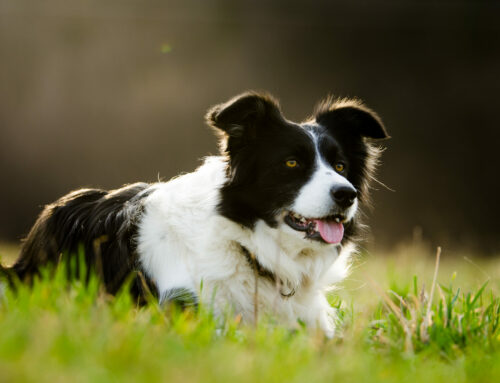Old age is a natural and inescapable part of life – time will take its toll on all of us, and on our pets too. Some of the changes we experience as we get older are true for our pets too. Things like changes to eyesight and hearing are very common.
Eyesight
Many animals can see movement much better than we can, but as they age they go through some normal changes that can reduce their vision. Many of us are familiar with the slightly white or milky appearance of an old dog’s eyes. This is usually caused by natural changes to the lens inside their eye causing it to become slightly cloudy, and which has very little impact on their day-to-day life. But this milkiness can also be due to cataracts, which are more serious and may require investigation and medical intervention. Both can come on slowly over time so, even with cataracts, pets often learn the layout of their environment and memorise it, enabling them to move around without problems. What you might notice is when things change they struggle or bump into things, for example if a chair is move, or a new object appears on the floor.
Hearing
Hearing loss is also very common, but often much harder to notice. Many of us use hand signals to communicate our commands to our pets, to ask them to sit, lie down, or come back to us, so vocal instructions are often backed up by a visual signal so they may seem to be able to hear us. An early sign of hearing loss is an animal becoming easily startled particularly when approached from behind, or woken up.
Both hearing loss and sight impairments can mean older animals become slower than they were, they become more timid of their surroundings than they used to be. But older pets can also suffer the early stages of old-age cognitive dysfunction – essentially similar to dementia in humans – which can cause them some distress, or to slow down too.
Stiff and sore?
One of the most common ailments in age for both humans and animals is arthritis. As we age our joints stiffen, we move less, and we might start to feel pain. Have you ever noticed that your cat no longer wants to jump onto the side in the kitchen for tea, that your rabbit is struggling to groom themselves, or that your dog is sleeping in the morning after he’s chased that football around the park? These are all subtle indicators of joint pain.
And along with sore backs or joints limiting their exercise, our pets’ metabolisms change too, which means they don’t burn calories at the same rate as they did when they were young. This makes it easy for them to gain weight, and even become obese over time. Less movement and getting heavier is a vicious cycle, which increases the pain suffered with arthritis.
Helping older pets
Whilst it does mean getting used to some changes, getting older doesn’t mean we expect to have any less of a quality of life, and we shouldn’t accept less for our animal companions either.
As we’ve talked about above, there are many things which can cause our pets to slow down as they age. Some changes we can help manage by making changes in the way we as owners behave, or in how we manage our pets’ surroundings, for example not moving furniture around, remembering to use hand signals, or even laying a rug down on top of a slippery floor to prevent slipping.
Other changes may need veterinary intervention – for example a limping pet, which is usually an indicator of pain, and often seen with arthritis. In these cases pain relief can make an enormous difference to how your older pet feels. In fact, it’s not uncommon for owners to trial pain relief medicine for a few weeks and report back their surprise and gratitude at “getting their pet back” to see the joy return to their daily life.
Sadly, as our pets get older the likelihood of them being affected by disease increases, ranging from male dogs developing prostate problems, through to tumours and cancer. The earlier these diseases are detected, the better the chances are that you and your vet can create a treatment plan to manage them.
So if you’re noticing that your pet is slowing down, we would recommend speaking to a member of our team, and they can help make an appointment with our vets, who can talk to you about your concerns, and examine your pet thoroughly, so that they can advise of any changes, tests or medications which will help maintain the best quality of life for your older animal.



